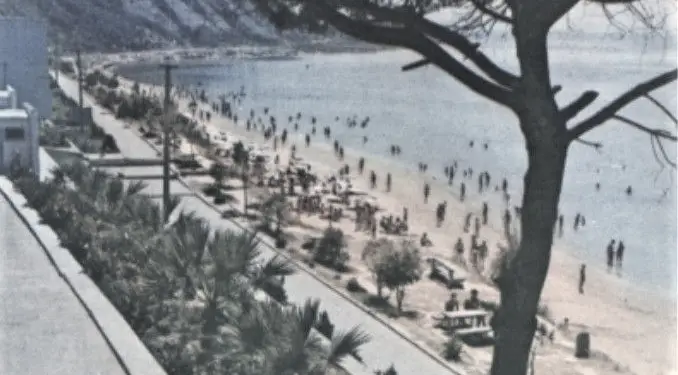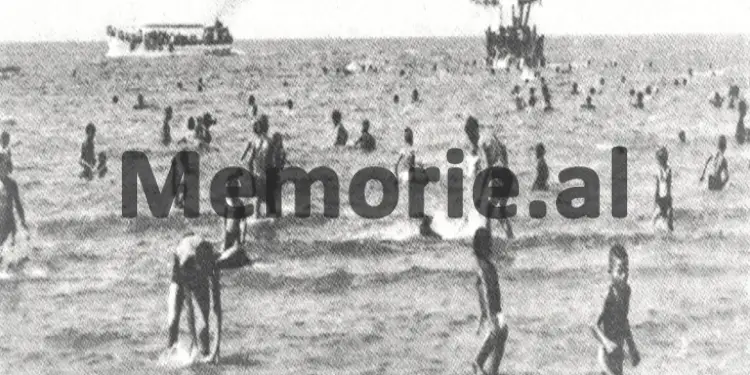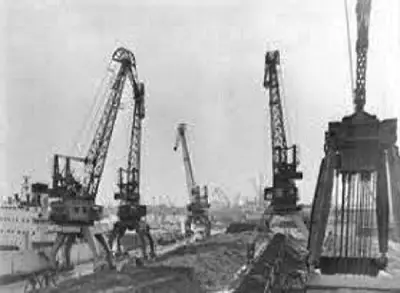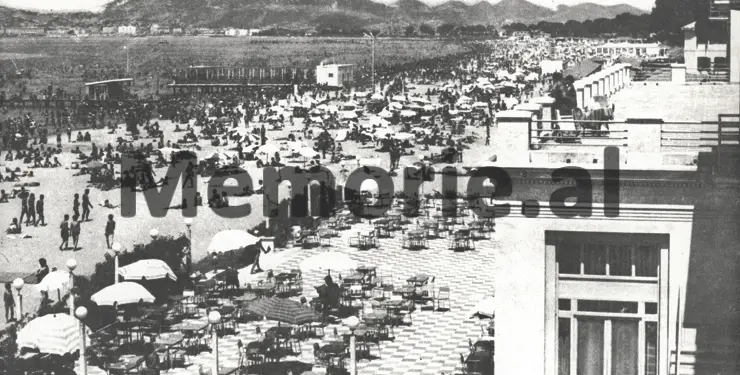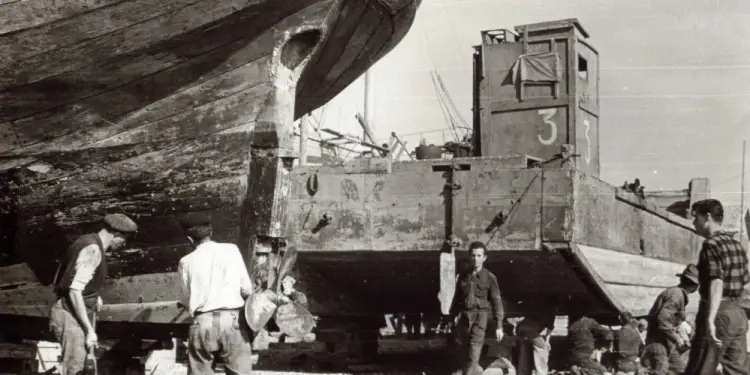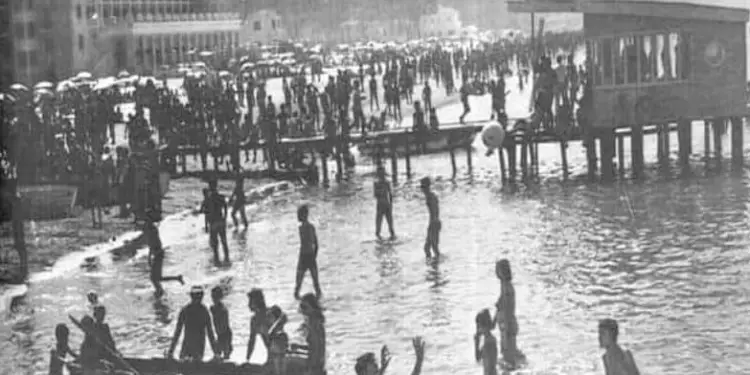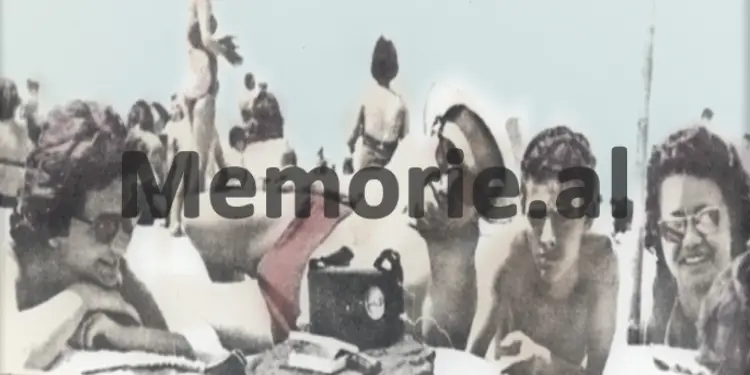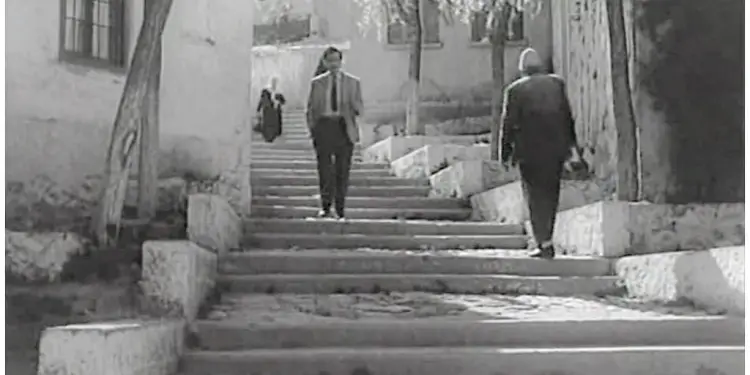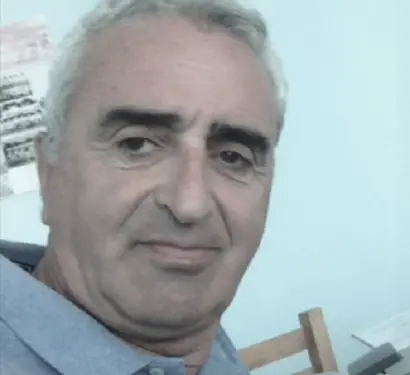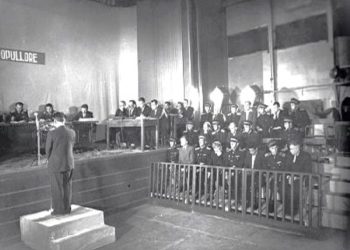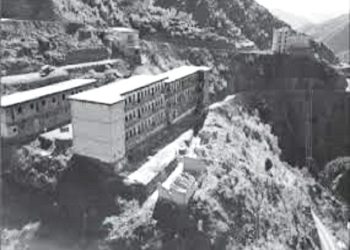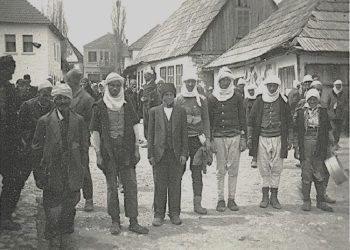From Uvil Zajmi
Memorie.al / What were the favorite beaches, and how did Albanians vacation before and after the 50s, especially those who preferred the sea? Durrës, the most important one, in the three months of summer, frequented by the aristocracy, the wealthy, but also by King Zog himself. Then the period of the 1960s – 70s – 80s were special for Albanians, individuals or families who loved the sea. In those beginnings, the beaches were few and Durrës, Vlora, Saranda were the most important ones. Shengjini started to be preferred later, as well as Divjaka, while Dhërmiu, or the Ionian coast, although it was liked, was limited by the distant, difficult journey and the limited possibility for systematization.
Continues from last issue
“Youth Groups”
It was a very aggressive period towards the capital’s youth in every direction, especially after the middle of 1975. They were called “Youth Groups”. Organized by youth organizations, they consisted of several young people who moved with the authority to stop any young man or woman who, according to them, demonstrated Western trends in clothing, attitude, etc. In particular, they were numerous and quite violent on Saturday or Sunday during the beach period. At the train station in Tirana, they systematically came out and stopped boys and girls, did not allow them to get on the train, when they saw their extravagant clothes, hair or long braces.
They took their names, school, or place of work to criticize them, or put them in a newspaper. But, even during the train journey, or arrival in Durrës, they came forward and checked the beachgoers. There were cases when they would take them to the barber or take them with them and they would shave them, take their clothes and not allow them to go to the beach. But, even during the beach, they stopped at the tents listening to foreign music, or if you wore a cross around your neck, they took it as a foreign show.
Walking trip to Durrës, to visit Biga “Adem Reka”
Winter, 1967, was the most spectacular march of Tirana citizens towards Durrës. Special and memorable because, not for the beach, or fun, but for a major issue for an event shocking for the time. The employee of the Sea Port, Adem Reka, had just lost his life in defense of the Biga, (large floating crane) which later took his name, he fell heroically in the line of duty, on a stormy night and when a bad weather threatened everything. Afterwards, his heroism turned into a reference point and symbol for the Albanian people.
He was declared a ‘Hero of Socialist Work’, and the drama, the film “Open Horizons”, (along with the unforgettable character, ‘Robert Çamçakëzin’, performed by the actor from Elbasan, the late Shpëtim Shmili, admired by the youth, as a modern type), were dedicated to his heroism. And to honor him, it was decided that the people of Tirana, respecting his heroic act, set off on foot as a sign of sacrifice, marching hourly towards Durrës, to visit closely the biga that he saved, now named: Biga “Adem Reka”. So, to Durrës, to the sea but not to the beach and not by train or other means, companies, schools, institutions, students, etc., have also gone on foot.
Does the food make fun of me even on the beach?
The famous clown has accompanied the Albanian citizens even during the holidays. As in the entire beach, also at “Iliria”, during the two-week period, the residents of the cabins or tents were given a coupon by the beach administration. On the parallel road in front of the cabins at the expense of the “Blok” – the leadership, there was a bakery shop, a toaster and a ‘Food-Dairy’, similar to a small market, where according to the name list of the head of the family, they were guaranteed a portion of meat or chicken, cheese, a bottle of oil, eggs, etc. In “Iliria”, there was no Police District, no pharmacy, no voice center, no ambulance and ambulatory service, as they were concentrated and located at “Kurudha”. Even the summer cinema, the only one along the beach area, was across the street, between “Hekurudha” and “Illyria”.
At the “Railway”, there was also the Telegraf-Telephone building, next to the Palace of Agriculture, which still exists there today, as a museum relic of the socialist period, but now in ruins and surrounded by newly built buildings after the 90s. (These are the years when important ministries or departments are oriented to build palaces on the beach for their employees). Meanwhile, in Iliria, there were also several one- and two-story villas, where families were housed, but they were also used by Sigurimi to monitor groups of tourists or Marxist-Leninist groups when they came to that sector.
Dance floor and secret love, with foreign girls!
They were placed in front of each other, only the sand separated them: To the east was the Pastry-Restaurant “Iliria” and to the west the track. The first one had a great flow throughout the day, it worked with non-stop service as the only pastry shop in that area, where it was also served in bathrobes, Turkish coffee, poncho, cognac, etc. To keep the refreshments cold, a large barrel filled with water was used and large ice cubes inside, where the orange bottles of Vap-ik were placed. There was a queue at the counter, when the barmaid with a wooden shovel brought out the ice cream produced by the Italian “Cantabriga”, which cost 5 ALL a cup, and 10 for two.
In front of the Patisserie was the Restaurant, with tables inside and outside, and a sign that read: “Do not serve in bathrobes”, which prohibited the waiters from serving. Every day at lunch or in the evening, you would see people who, in order to secure a table, stood waiting for one to become empty or free. This is more so at the end of the week when “extra” vacationers disembarked from Tirana. The same goes for the runway, where in the morning I also serve in bathing suits, unlike at lunch and dinner. (This was a rule for all restaurants, tracks, a T-shirt or shirt was enough to serve). Together with that of the “Railway”, designed in water, the track of “Illyria” was longer and went deeper into the sea.
Although with a small area, it was frequented by its customers, even by those who sat down in the morning and stayed there all day without moving until it closed at midnight. Even here, in order to secure a table, one of the family members would leave the beach at noon when the sun had not yet set, and sit blocking a family table for the evening. Both had an orchestra, where there was also dancing. Although not the place of acquaintances and sensational “love stories”, that track has been used a lot for secret loves with foreign East German girls who, in order to avoid the pursuit of the Security, left “Adriatic” and came to “Illyria” as a meeting point between them and Albanian youth. In winter, these areas, due to the lack of vacationers, remained deserted and there were children playing football or skating.
Trampoline and swimming “up to the barrel”
Going to the beach as soon as possible, opening the pit with circumstantial means to place the tent as close to the sea as possible, was a daily ritual performed by a family member. Standing on the sand was without a bed, or with modern tools like today. A basme or something else was used for sitting, lying down and placing the food, when the lunch taken from home was eaten in the tent for the day campers. (In other cases, the shadows of the surrounding poplars were used). Special were the improvised sun umbrellas with sheets, which were tied to the four tops of the sticks embedded in the sand.
The day was spent playing cards, the famous 5 x 4, spathi, xing, chess, etc. Each sector had its own trampoline, and then came the barrels: The first allowed you to go swimming, the second stopped it and the third (when there was one) served only for day-rent boats with paddles that were taken from the “Railway” and were controlled if you exceed this limit. Car tires, or those sold in local stores, were also used as floatation tools. Many vacationers, mainly those from Dursas, in order not to take their umbrellas with them on their daily commute, left their umbrellas at a restaurant, in a store, or at an acquaintance in the cabins.
In the months of June and September, there were few vacationers; more came from the districts, retired families, since it was easier to secure a cabin or camp sheet, or those who did not have children for school, since September 1 was the start of the school year. This period was also used and liked by athletes, mainly from “November 17”, who during the month of June, came to stay in tents, then in ordinary cabins, until the club took over a villa in the former Police building for the summer training of his athletes.
“Block” to the leadership, forced separation by wire…!
Similar to that of Tirana, such was also the one after “Illyria” where mainly the families of the Political Bureau, the Central Committee of the PPS, the People’s Assembly, etc. stayed. Known as the “Stabilimenti”, in those beginnings there were two “U”-shaped rows of one-story cabins made of wood and a few walls, built and used by the Italian soldiers, who left them when they left. A small bar next to them and some villas, which were then transformed for the governors. The “Block” was initially a small area, then it expanded and took on a different appearance, it was surrounded by being frequented by Enver Hoxha, as a clean territory, close to Tirana, far from the noise or the flow of mass movements, since in that completely isolated area and no one inside it without authorization could enter it.
Even from a distance, that gigantic space dominated by a large green, looked like a desert and without human breath. The “Block” and “Illyria” were separated by a low wire, the soldier who was on duty checking the depth in front of the “Block”. What is remembered and remains special for vacationers, or enthusiasts of the great daily and evening tour, was the spectacular forced turn that was performed a few meters before the wires. As the children of the leadership frequented the tour, stay and friendships at “Breshka”, to get out of “Block”, they crossed the perimeter wire that continued for about 15 meters, entering the sea with the water slightly above the knee.
Villa “Lule”, the symbol of “Illyria”
“Illyria” has been an area known for several villas, among which the most important one, a beautiful three-story building, which has served as a reference point and which has remained in the memory of every Illyrian beachgoer, after passing by there, to go out on the beach back to the cabins. Starting from a photo left from that time, owned by the family, but rare, with which begins the unique story for the time of that beautiful building near and facing the sea, designed by the famous architect Kristo Sotiri, in 1935, which he called Vila “Lule”. Then the nationalization, the departure of family members, among them the one who thought it up.
The story of the architect who designed it…!
Kristo Sotiri, born in Pogradec in March 1870, completed his education in Romania, first in Tucla then in Galaci, whiles his higher studies in Italy, at the University of Padua and in 1898 he graduated as a civil engineer. After that, he continued his studies at the Academy of Fine Arts in Venice, receiving his second degree, now as an architect. Still a student at the Academy, he meets and marries Countess Bianca Maria Querini, one of Venice’s oldest aristocratic families. From this marriage, the couple gave birth to a daughter, who was named Querina. For work reasons, at the end of the first decade of the last century, architect Sotiri returned to Romania, then to Albania around the 20s, engaged in the World Affairs office in Korça.
Then presidential architect and with the arrival of Zog, architect of the Royal Court, moving to Durrës. In 1932, his wife Bianca died and two years later he married Juliana Kačinari, with whom he had two sons, Salvatore and Vangjeli. After the end of the War in 1945, he was appointed an engineer at Rruga Ura, at Construction, in the General Directorate of Ports. He passed away on February 28, 1953, leaving behind colossal works, among which Vila e Zogut, the Mausoleum of Martyrs in Durrës, but also projects, such as those of the Municipality of Tirana, the Train Station, the former National Library, the former -The Palace of the Princesses – then the Palace of the Pioneers – Tirana, a villa in Shiroka, the Metropolitan Church, that of the Vlachs in Korca, family residences, as well as many constructions in Romania, Venice, etc.
A gift for the wife!
“Father started the construction of the villa around the 30s”, remembers Salvator Sotiri, the son of Kristo Sotiri, the architect. “He had designed it as a three-story building with three domes, on the first line of the beach, to spend summer vacations. For its construction, he hired well-known builders from Tirana, among them Rexhep Çitakun. He baptized it with the name “Vila Lule”, as a gift for our wife and mother, Juliana. We are two brothers and we were born and raised in that villa until 1945 and we lived there.
I was 10 years old, when we abandoned it because together with the other villas that are next to it, one and two stories, located on the first line of sand, among them the Camp of Pioneers that served as a summer villa for Ahmet Zogun , were naturalized and sent us to live and work in Durrës. We had difficulties, until we settled in the palace where we stayed until the 90s. We had lost hope that one day we would return to where we had left and separated half a century ago”.
Other residents, frequenters…?!
Villa “Lule” was covered with two large poplars with a fresh veranda from the shade of the trees. Later it was surrounded by 3 bunkers. In the period of great influx, some of the families of the members of the Central Committee or other government officials brought them to the villas of “Illyria” and the one next to the “Lule” villa was adapted as a canteen for them. In winter, the villas of “Illyria” were closed and the keys were kept by the administration of the Reception Directorate, which together with those of “Blok” took care of their maintenance.
“We from Durrës used to go to the beach and we had the center at the villa. It had several stairs, a corridor, where we left our loot or bicycles,” Salvatori recalls. “Together with my brother Vangjeli, (who unfortunately passed away some time ago), we used to stay next to her, as we had spent our childhood there. We looked at it with nostalgia; we didn’t even tell the man that it was ours. How close and how far it seemed to us.”
Nostalgic epilogue…!
A wonderful Italian song, recently sung by M. Vandeli, Dik Dik, Camaleonti, groups, singers of the 70s, that brings back my emotions, to that beach, those songs, that youth, that generation. An outstanding text:/ Memorie.al




